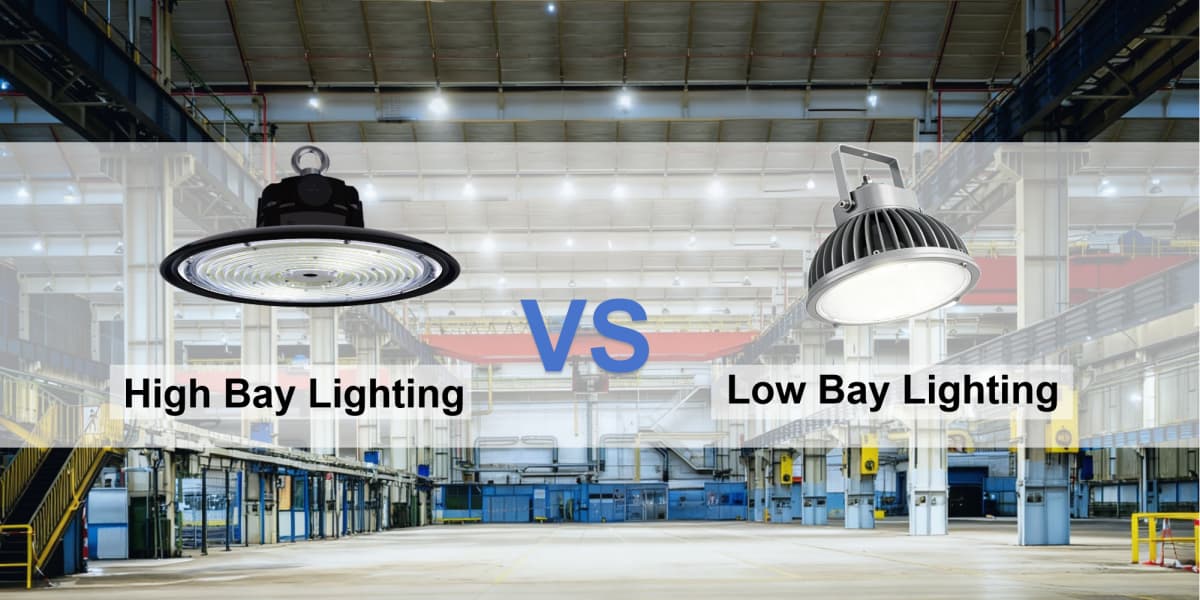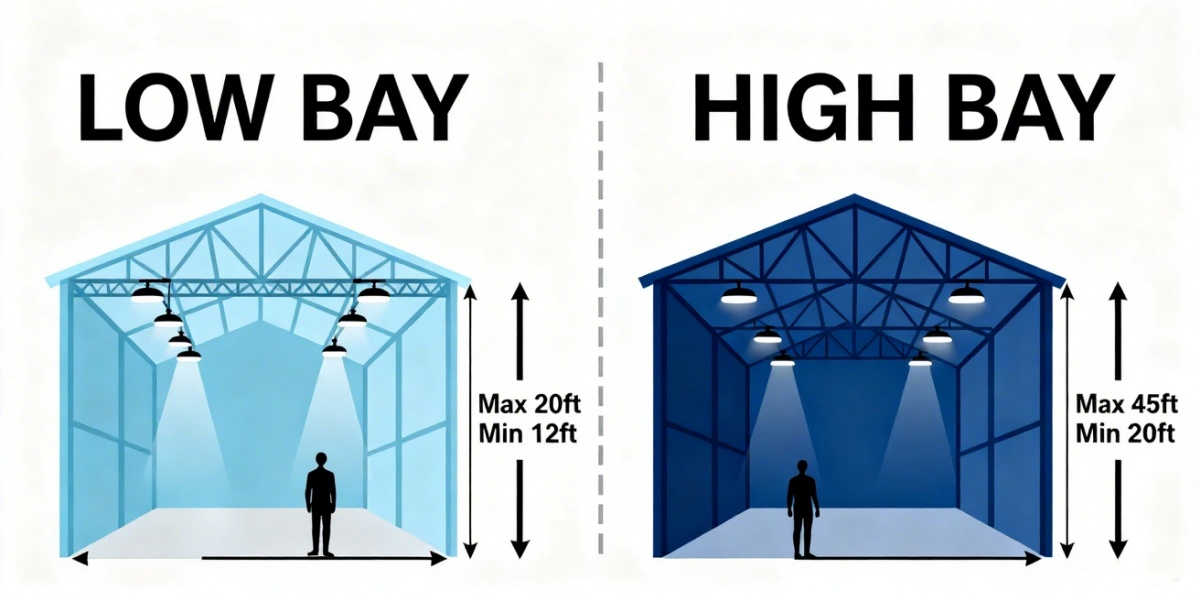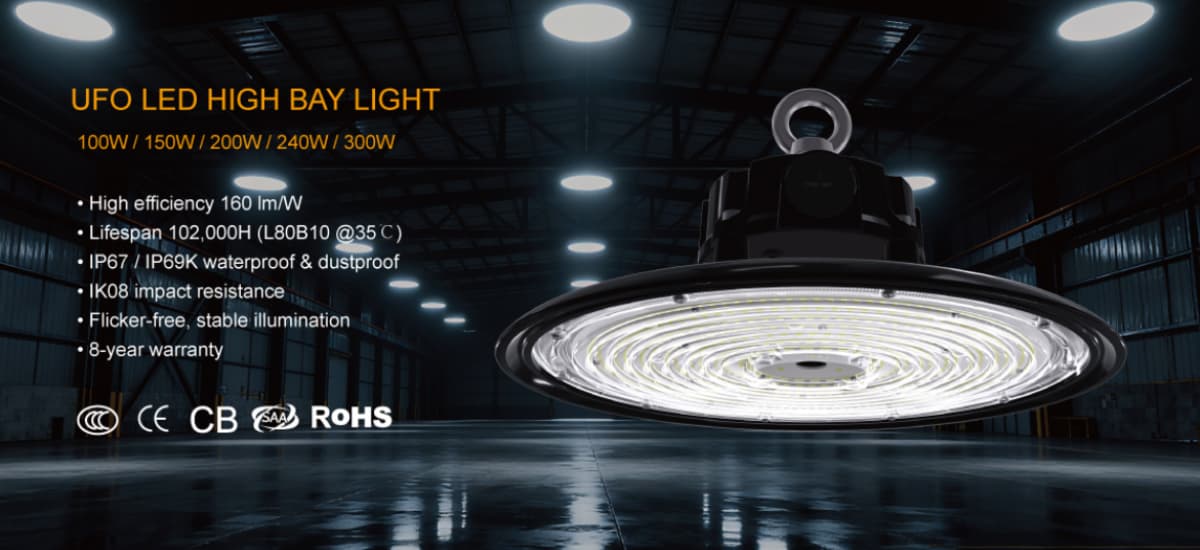ハイベイ照明とローベイ照明:実際の違いは何ですか?

導入
工場の天井を見上げて「なぜこんなにたくさんの種類の照明があるんだろう?」と不思議に思ったことがあるなら、それはあなただけではありません。ハイベイ照明とローベイ照明のどちら が良いかという議論は、 多くの倉庫管理者や請負業者を悩ませてきました。
こう考えてみてください。ハイベイライトは、垂木から光を放つように設計された、産業用照明の強力な投光照明です。一方、ローベイライトは、天井まで照らす必要がない、より現実的な照明器具です。
このガイドでは、これら 2 種類の照明の違い、それぞれの最適な設置場所、そして最新の LED テクノロジーがなぜ状況を根本的に変えるのかについて詳しく説明します。
目次
LED と蛍光灯のベイ照明: どちらの性能が優れていますか?
施設に適したベイ照明を選択するにはどうすればよいでしょうか?
ベイ照明とは何ですか?
ベイ照明とは、工場、倉庫、体育館、大型小売店など、広く開放された屋内空間向けに設計された照明システムを指します。これらのエリアでは、作業員が明瞭に視界を確保し、安全に移動でき、生産性を維持するために、明るく均一な照明が必要です。
簡単に言えば、ベイ照明は天井の高さに基づいて 2 つのタイプに分けられます。
ハイベイ照明- 約 20 フィート以上の天井に使用されます。
ローベイ照明- 天井の高さが約 20 フィート未満の場合に使用します。
この違いは重要です。天井が高くなると、床に十分な光を届けるためには、ビームをより強く、より狭くする必要があるからです。
かつては多くの施設でメタルハライドランプや蛍光灯の照明器具が使用されていました。
今日では、LEDベイ照明は、 そのエネルギー効率、長寿命、そして安定した明るさにより、標準となっています。あらゆる産業空間や商業空間において、信頼性が高くメンテナンスの手間が少ない照明を提供します。
ハイベイ照明とローベイ照明の違いは何ですか?
工業用または商業用の照明計画を設計する際には、ハイベイ照明とローベイ照明の違いを理解すること が不可欠です。どちらも広い空間に適していますが、設置場所や性能は天井の高さ、必要な明るさ、ビームの分布によって異なります。
(1)設置高さ
最初かつ最も重要な要素は天井の高さです。
ハイベイライト は、天井高が20フィート(6メートル)を超える場合に使用します。明るさを損なわずに、床まで届く強力で集中した光を照射します。
ローベイライトは、天井高が20フィート(約6メートル)以下の 場合に最適です。光をより広範囲に拡散するため、明るすぎる部分やぎらつきを防ぎます。
間違ったタイプを選択すると、エネルギーが無駄になったり、照明が不均一になったりする可能性があります。

(2)応用
ハイベイ照明は、倉庫、生産工場、航空機格納庫、スポーツアリーナなど、天井が高く垂直方向のスペースが広い場所 でよく使用されます。
ローベイ照明は、天井が低く、作業員がより柔らかく広い照明を必要とする作業場、小売店、ガレージ、組立室など に適しています。
適切な組み合わせにより、日常業務における安全性と可視性が向上します。
(3)ビーム角
ビームの設計によっても 2 つのタイプが区別されます。
ハイベイ照明器具では、より狭いビーム (60°~90°) を使用して 光をさらに下方に照射します。
ローベイ照明器具はビーム幅 が広く(100°~120°)、 低い高さでも光を均等に広げます。
これにより、ワークスペース全体で一貫した明るさが確保されます。
(4)取り付け
ハイベイライトは通常、チェーン、フック、またはペンダントで吊り下げられますが、ローベイライトは表面に取り付けたり、短い距離で吊り下げたりすることが多いです。取り付け方法によって、光の広がりをコントロールし、メンテナンスが容易になります。
(5) ワット数とルーメン出力
パフォーマンスの違いは数字からも明らかです。
ハイベイ:150~400W、約15,000~40,000ルーメンを生成。
ローベイ:60~150W、約6,000~15,000ルーメンを生成。
まとめると、 ハイベイ照明は高い位置から光を集中させ、ローベイ照明は地面に近い位置から光を拡散させます。この違いを理解することで、施設の効率と快適性を最大限に高める適切な照明器具を選定できます。
LED と蛍光灯のベイ照明: どちらの性能が優れていますか?
LEDベイライトと蛍光灯を比較すると、性能と長期的な価値の違いは明らかです。LEDは、ヨーロッパやアメリカの工場、倉庫、作業場で急速に人気が高まっています。
エネルギー効率
LEDベイライトは、蛍光灯と同等以上の明るさを保ちながら、最大70%の消費電力を削減します 。これは電気代と二酸化炭素排出量の削減を意味し、どちらも現代の産業施設にとって大きなメリットとなります。
明るさと品質
LEDは、優れた演色性を備え、ちらつきのない均一な光を提供します 。作業者は細部や色をより正確に見ることができ、安全性と生産性が向上します。一方、蛍光灯は、時間の経過とともにちらつき、色褪せ、明るさの低下が起こります。
メンテナンスと寿命
A quality LED bay fixture can last 50,000 hours or more, often five times longer than fluorescent tubes. There are no ballasts to replace and no fragile glass to handle.
Instant-On & Control
LEDs turn on instantly and integrate easily with motion sensors or smart controls, something fluorescent lights can’t do effectively.
For these reasons, LEDs dominate industrial retrofits — offering stronger light, lower costs, and less downtime for maintenance.
High Bay LED Lights vs Low Bay LED Lights
When both lighting types move into the LED era, the difference between high bay LED lights vs low bay LED lights becomes more about engineering design than basic height or brightness.
Optical Design
LED technology allows light to be shaped with precision lenses rather than old-style reflectors.
High bay LEDs use narrow, high-intensity lenses to push light down from 20–50 feet, ensuring uniform brightness across tall spaces.
Low bay LEDs use wider beam optics to cover shorter distances with softer, more comfortable light.
This optical control reduces glare and improves energy efficiency per lumen.
Heat Dissipation
Because high bay fixtures run at higher wattages, they require larger aluminum heat sinks or active cooling designs to protect LED chips. Low bay units generate less heat, so they often feature compact passive cooling that keeps fixtures lighter and easier to mount.
Smart Controls & Integration
Modern industrial LED lighting supports motion sensors, daylight harvesting, and IoT control systems. High bay models often use networked or wireless systems for energy savings in warehouses, while low bay lights integrate simple occupancy sensors for smaller areas.
Efficiency & Reliability
Both types now exceed 150 lumens per watt, offering powerful, consistent light with minimal maintenance.
Ceramiclite provides high bay LED lighting solutions designed for industrial environments — combining optical precision, durable materials, and smart control compatibility to meet diverse facility needs.
Which Should You Choose — High Bay or Low Bay?
Now that we've outlined the key differences, you're probably wondering: "So which one is right for MY space?" The right choice boils down to your ceiling height, lighting needs, and work environment.
Instead of getting lost in the details, use the quick-reference guide below to make an initial determination.
The right choice depends on your ceiling height, lighting needs, and work environment. Each type serves a specific purpose, and picking the right one ensures both efficiency and comfort.
Here’s a quick guide to help you decide:
Condition | Recommended Lighting | Reason |
Ceiling above 20 ft (6 m) | High Bay | Delivers concentrated brightness with a narrow beam angle to reach the floor evenly. |
Ceiling below 20 ft | Low Bay | Offers a wider beam for softer, more diffused light. |
Warehouses / factories / gymnasiums | High Bay | Designed for high illumination intensity and large spaces. |
Retail stores / garages / workshops | Low Bay | Provides balanced brightness and better visual comfort for smaller areas. |
Tip: When in doubt, choose based on your lux requirement — high bay for power, low bay for comfort.
For a more detailed analysis of each factor—like calculating exact brightness needs or selecting the perfect beam angle—continue to the next section, where we break down the complete selection process.
How to Choose the Right Bay Lighting for Your Facility?
Selecting the right fixture can make or break your lighting performance. When you choose the right bay lighting, the goal is simple — achieve consistent brightness, reduce energy costs, and maintain long-term reliability. Here’s a quick guide to help you decide.
(1) Beam Angle and Width
Start with your ceiling height.
For ceilings above 20 ft, use narrower beams (60°–90°) to concentrate light on the work floor.
For ceilings below 20 ft, choose wider beams (100°–120°) for smoother, more even coverage.
This ensures your light reaches the right area without glare or dark spots.
(2) Mounting & Distribution
Consider your mounting options: chain, pendant, or surface mount.
High bay fixtures are often suspended to control light spread.
Low bay fixtures can be surface-mounted for a cleaner look.
Proper mounting height directly affects light distribution and maintenance access.
(3) Retrofitting Existing Fixtures
If your facility already uses older metal halide or fluorescent lights, LED retrofits are the fastest way to cut energy use and improve brightness. They fit existing mounts, minimizing installation cost and downtime.
(4) Power & Brightness
Use lumens per square foot as your guide:
Storage areas: 10–20 lm/ft²
Assembly or production: 30–50 lm/ft²
Inspection zones: 70+ lm/ft²
Focus on lumen output, not just wattage, to ensure efficient lighting design.
(5) Color Temperature
A neutral white tone between 4000K and 5000K gives the best visibility for industrial work. It reduces eye strain and enhances material contrast.
(6) Shape: UFO vs Linear Fixtures
UFO high bay lights deliver strong, centralized illumination — ideal for large, open areas.
Linear low bay lights spread light evenly across aisles or production lines, perfect for lower ceilings and rectangular layouts.
Visualizing this helps match fixture shape with your room geometry.
(7) Energy Usage & ROI
Calculate your return on investment (ROI) based on energy savings, lifespan, and reduced maintenance. Most LED systems pay for themselves within 1–2 years, then continue saving for over a decade.
By following these steps, facility managers and engineers can confidently select lighting that improves safety, productivity, and energy efficiency — all while ensuring the best long-term value for their operation.
Why LED Bay Lights Are the Future of Industrial Lighting?
The shift toward LED bay lights is more than a trend — it’s the future of industrial lighting. Across Europe and the US, factories and warehouses are moving away from traditional fixtures to smarter, more efficient LED systems that support long-term sustainability goals.
Modern LED bay lights do more than just illuminate. They connect. Integrated motion sensors, daylight harvesting, and IoT controls allow lights to adjust automatically based on occupancy or ambient light levels. This reduces wasted energy and extends fixture lifespan while keeping workspaces consistently bright and safe.
Governments and corporations are also driving change. Energy-efficiency standards and ESG requirements now encourage facilities to cut power use and carbon emissions. LEDs make compliance simple — delivering high output with low consumption.
Looking ahead, LED lighting will become the backbone of smart, data-driven facilities, where lighting systems communicate with HVAC, security, and production networks.
Ceramiclite’s HB01 High Bay LED bay lights are engineered with these innovations in mind — combining optical precision, smart compatibility, and industrial-grade durability. They’re ready for today’s efficiency demands and tomorrow’s intelligent infrastructure.
Want to know more about What is New in Industrial LED Lighting?
Conclusion
Choosing between high bay vs low bay lighting comes down to three key factors — ceiling height, beam angle, and brightness needs. High bay lights deliver powerful, focused illumination for tall spaces, while low bay lights provide softer, wider coverage for lower ceilings.
Upgrading to LED bay lighting ensures higher efficiency, lower maintenance, and long-term ROI — a smart move for any modern facility.
どのオプションがあなたのスペースに適しているかまだお悩みですか?今すぐCeramicliteの無料照明レイアウトを入手して 、産業環境に最適なパフォーマンス、コスト削減、信頼性のバランスを見つけてください。
_thumb.jpg)

